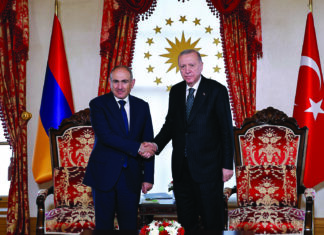FRANKFURT — Loss of life is the greatest cost of war, and in the continuing Azerbaijani aggression against Artsakh and the Republic of Armenia, casualties have been high. Along with destroying human lives, expelling Armenians and devastating their property, Azerbaijan has pursued a campaign to erase evidence of the physical and cultural existence of the Armenian people in the region. This includes destroying cultural and religious monuments, turning churches into mosques, and changing place names.
Raffi Kantian, chairman of the German-Armenian Society (DAG) and editor of their journal, Armenian-German Correspondence (ADK), has recently exposed a related case of mistaken cultural identity in an important venue in Germany. And, happily, his intervention should lead to a restoration of the truth.
Pictures of an Exhibition
It all began, as documented on the DAG website (https://www.deutscharmenischegesellschaft.de/), in late summer, when two photos posted on Facebook made the rounds. The pictures are from the Archaeological Museum in Frankfurt (Main), and depict Urartian exhibits and a map. Kantian examined the images, then posed the question: “What does Urartu have to do with Azerbaijan?” In fact, the showcase was labelled “Azerbaijan.” Kantian also asked why the map accompanying the exhibit should also bear the name “Azerbaijan.”
It is well-known, he wrote, that the Baku regime has consistently tried to find Azerbaijani footprints everywhere, claiming that not only Yerevan and a Persian mosque in the Armenian capital, were Azerbaijani, but also that southern Armenia itself had long been part of Azerbaijan. Perhaps, he noted, here was yet another attempt at the same falsification.
What’s in a Name?








